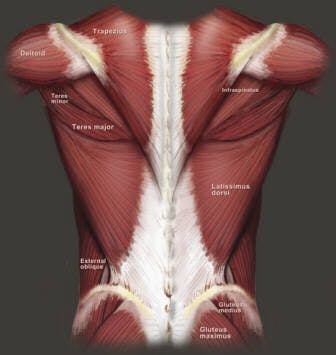
Lesson 12: Functional Anatomy by Joint Action and Exercise of the Upper Body
Functional anatomy of the scapula, shoulder, and elbow. Joint actions, muscles, exercises, and planes of motion for the upper body. Detailed analysis of the pectoralis major, latissimus dorsi, teres major, deltoids, rotator cuff, and scapular muscles.
Course Description: Functional Anatomy by Joint Action and Exercise of the Upper Body
This course includes tables of all joint actions permitted at each of the large joints of the upper body, along with the muscle groups that contribute to those joint actions. Note, these are the muscle groups responsible for producing these joint actions concentrically. Examples of concentric actions during exercise include, from the starting position to the bar near the chest during a lat pull-down, or from the floor back to the starting position during shoulder-width push-ups.
The course includes the functional anatomy of the scapula (scapulothoracic joint), shoulder joint (glenohumeral joint), and elbow joint (humeroulnar joint). Examples include the serratus anterior, upper trapezius, and lower trapezius contributing to upward rotation; the latissimus dorsi, posterior deltoid, teres major, and long head of the triceps brachii contributing to shoulder extension; or the anterior deltoid, the clavicular head of the pectoralis major, coracobrachialis and biceps brachii contributing to shoulder flexion.
Additionally, this course includes a learning activity to test your knowledge of functional anatomy. You will be asked to analyze compound movements and exercises commonly included in an upper-body workout plan or strength training routine. The exercises include single joint exercises like the reverse fly and chest fly, and compound movements like the close grip row (seated row), chest press (bench press or dumbbell press), lat pull down (pull-up), overhead press (military press), and close grip push-ups. Note, you will be asked to analyze the concentric phase (not necessarily the first phase to follow from the starting position)
Sports medicine professionals (personal trainers, fitness instructors, physical therapists, massage therapists, chiropractors, occupational therapists, athletic trainers, etc.) must master functional anatomy to analyze human movement, and develop sophisticated exercise programs and therapeutic (rehabilitation) interventions. Further, this course is essential knowledge for future courses discussing advanced human movement science like patterns of shoulder joint dysfunction (e.g. altered rotator cuff recruitment), the synergistic function of muscles (e.g. contribution of core muscles to upper body motions), the role of upper body muscles in injury (e.g. upper arm or shoulder impingement pain, pectoralis major tear, rotator cuff rupture – you don’t always need surgery, etc.), and sports performance (e.g. best upper body exercises for building strength, increasing muscle mass, and improving sports performance).

Study Guide: Functional Anatomy by Joint Action and Exercise of the Upper Body
Functional Anatomy of the Scapula
Functional Anatomy of the Shoulder
Functional Anatomy of the Elbow
Common Upper Body Exercises: Activity
Common Upper Body Exercises: Answer Key
Bibliography
© 2024 Brookbush Institute. All rights reserved.

